
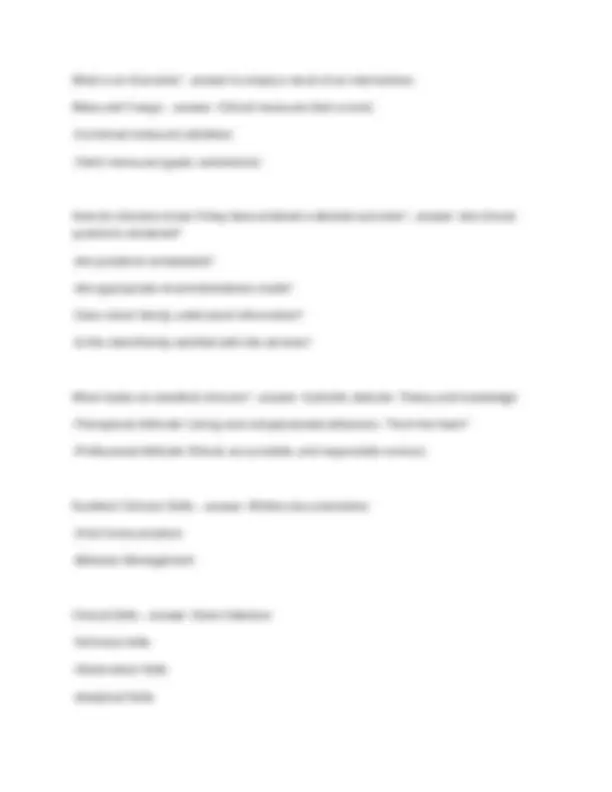
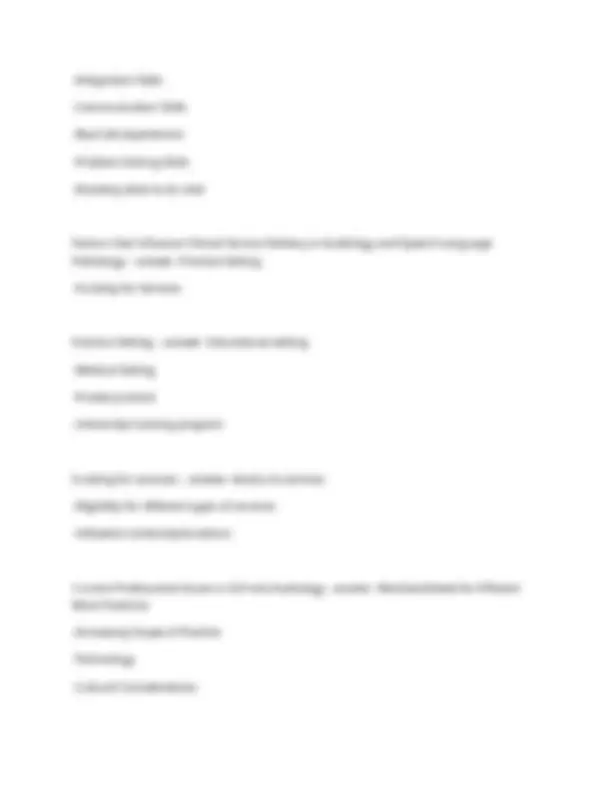
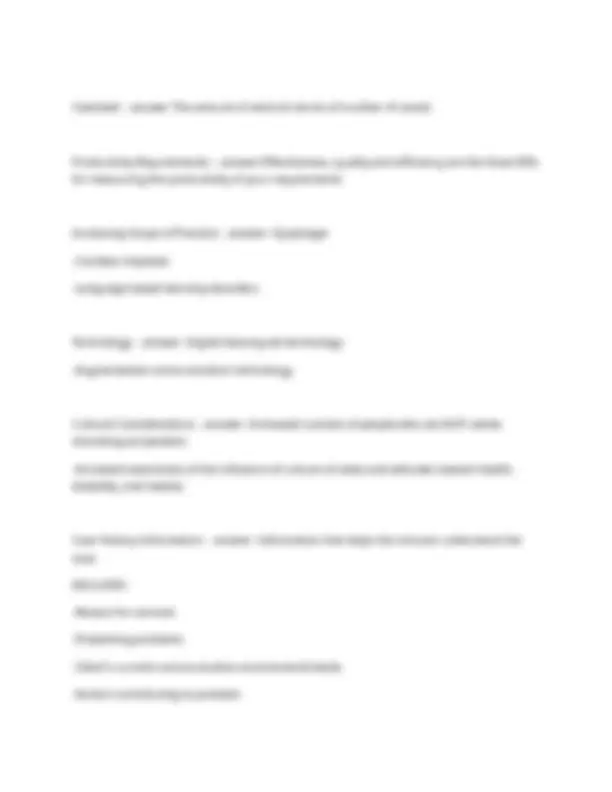
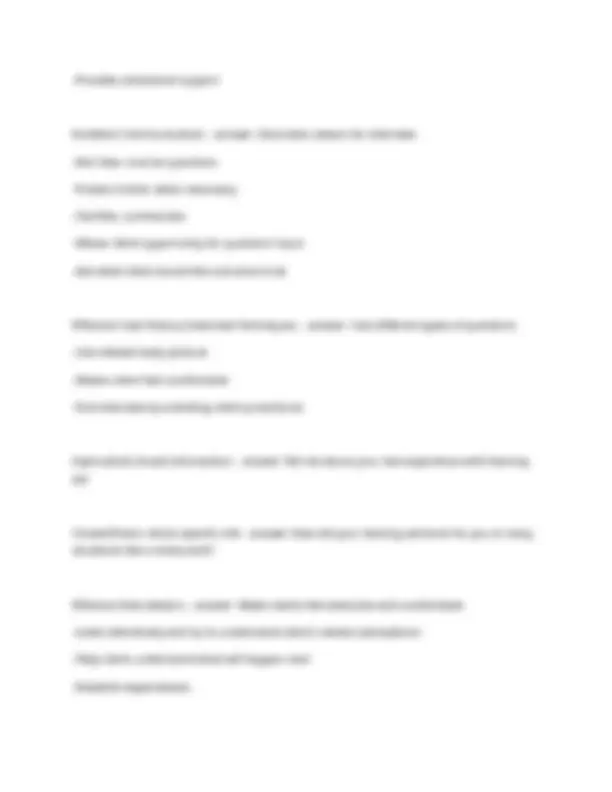
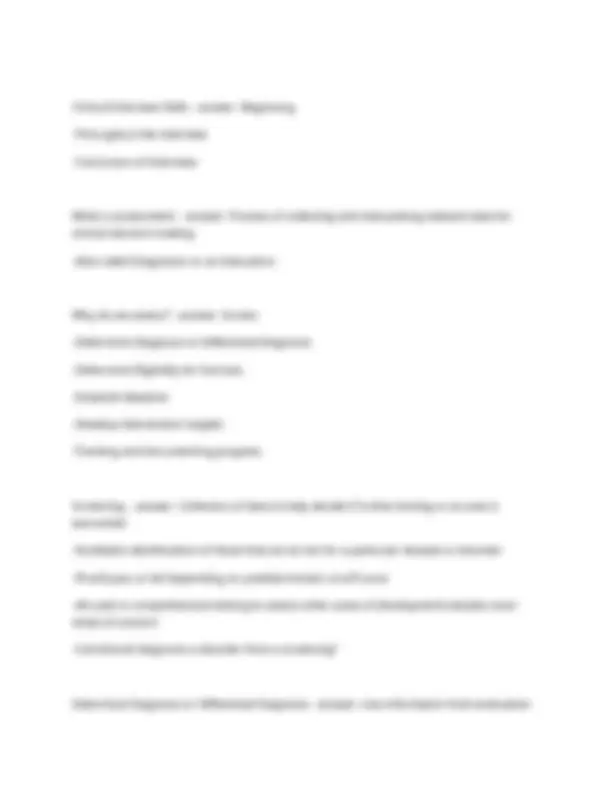
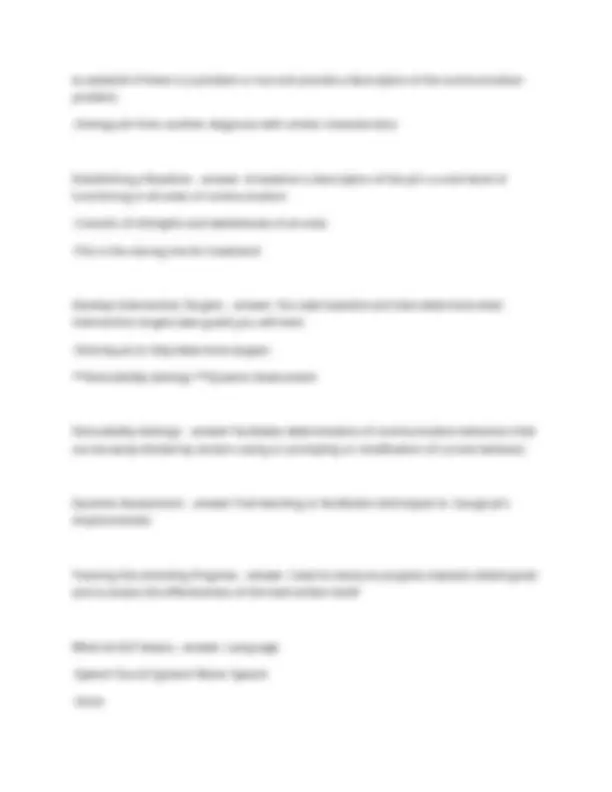
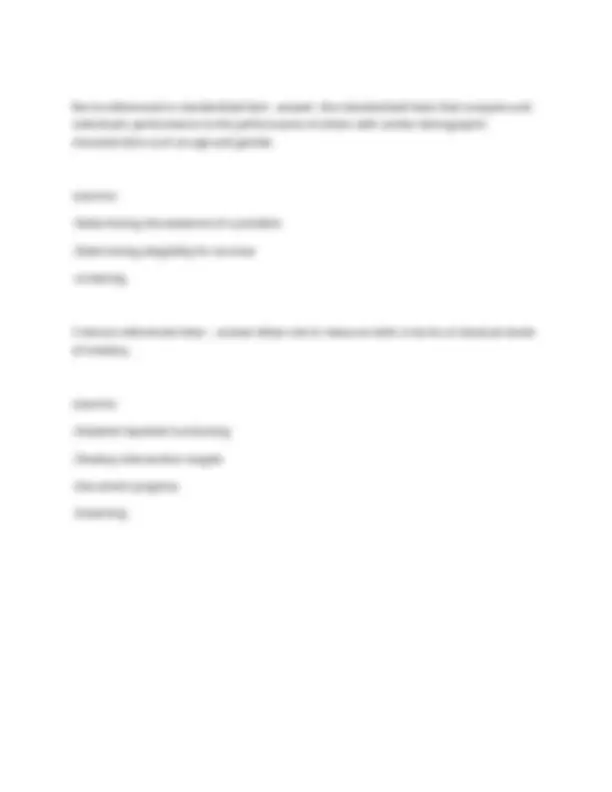


Study with the several resources on Docsity

Earn points by helping other students or get them with a premium plan


Prepare for your exams
Study with the several resources on Docsity

Earn points to download
Earn points by helping other students or get them with a premium plan
Community
Ask the community for help and clear up your study doubts
Discover the best universities in your country according to Docsity users
Free resources
Download our free guides on studying techniques, anxiety management strategies, and thesis advice from Docsity tutors
ASLP 4060 TEST 1 QUESTIONS AND VERIFIED ANSWERS.
Typology: Exams
1 / 13

This page cannot be seen from the preview
Don't miss anything!








Audiologist: - answer Profesionals engaged in autonomus practice to promote healthy hearing, communication competency, and quality of life for persons of all ages through the prevention, identification, assessment, and rehabilitation of hearing, auditory function, balance, and other related systems. Speech Language Pathology - answer Professional who engages in professional practice in the areas of communication and swallowing across the life span. Communication - answer Includes speech production and fluency, language, cognition, voice, resonance, and hearing. Swallowing - answer All aspects of swallowing including related feeding behaviors. Clinical Service Delivery - answer Is the practice of our field. Delivering services by providing clients with testing, treatment, education and counseling. Clinical Service Delivery Model - answer -System used to organize speech/language and hearing programs within employment settings. -Define our roles in rehabilitation of individuals with communication disorders. 3 Clinical Service Delivery Team Models - answer -Multidisciplinary -Interdisciplinary -Transdisciplinary *Used to identify the relationship shared by team members in the facilitation of patient/client progress Multidiciplinary - answer Each discipline conducts own assessment and develops discipline-specific goals. Each discipline has its own plan. Interdisciplinary: - answer Each discipline conducts own assessment but communicates with other disciplines regarding results.
Fosters complementary goal development and each discipline creates its own plan for the client. Transdisciplinary: - answer -Team members have an ongoing dialogue, sharing of information, knowledge and skills to develop and implement a single integrated service plan for a client. -A single assessment is completed in unison by professional from several disciplines. Types of Clinical Service Delivery Features - answer -Direct Services: Hands-on -Indirect Services: Consultation How a client is treated? - answer -Individual -Group Clinical Service Delivery Components: - answer -Intervention -Counseling -Case Management Steps to Clinical Practice: - answer -Referral -Case history gathering -Interview -Evaluation -Treatment -Dismissal What makes excellent clinical service delivery? - answer -Treatment that is appropriate -Treatment that is effective -Treatment that is efficient -Desired outcome (goals/ functionality) is achieved -Client/ family is satisfied All clinical service delivery: - answer Is directed at achieving a specific outcome
-Integration Skills -Communication Skills -Real Life experiences -Problem-Solving Skills -Knowing what to do next Factors that influence Clinical Service Delivery in Audiology and Speech Language Pathology: - answer -Practice Setting -Funding for Services Practice Setting: - answer -Educational setting -Medical Setting -Private practice -University/ training program Funding for services: - answer -Access to services -Eligibility for different types of services -Utilization (intensity/duration) Current Professional Issues in SLP and Audiology - answer -Workload:Need for Efficient Work Practices -Increasing Scope of Practice -Technology -Cultural Considerations
Caseload: - answer The amount of work (in terms of number of cases) Productivity Requirements: - answer Effectiveness, quality and efficiency are the three KPIs for measuring the productivity of your requirements Increasing Scope of Practice: - answer -Dysphagia -Cochlear Implants -Language based learning disorders Technology: - answer -Digital hearing aid technology -Augmentative communication technology Cultural Considerations: - answer -Increased number of people who are NOT native, monolingual speakers -Increased awareness of the influence of culture of views and attitudes toward health, disability, and medice Case History Information: - answer -Information that helps the clinician understand the case INCLUDES: -Reason for services -Presenting problems -Client's current communication environment/needs -Factors contributing to problem
Case History Interview: - answer -Is first step in evaluation/treatment -Goals: *Understand client's perception of problem, reason for appointment *Review questions/ significant information from case history form *Gather information about client's functional communication needs -Define expectations/goals -Understand resources -Orient client to evaluation/ treatment procedures -Establish rapportt Clinical Skills needed for effective interviewing - answer -3 Therapeutics Attitude Skills **A trusting Attitude **A positive and supportive attitude **An attitude of excellent communication Establish Trust: - answer -Appears confident -Undivided attention -Engaging Positive and supportive - answer -Sensitive to differing values, cultures, and life situations -Non-judgmental
-Provides emotional support Excellent Communication: - answer -Describes reason for interview -Ask clear, concise questions -Probes further when necessary -Clarifies, summarizes -Allows client opportunity for question/ input -Ask what client would like outcome to be Effective Case History Interview Techniques: - answer -Use different types of questions -Use relaxed body posture -Makes client feel comfortable -End interview by orienting client procedures Open-elicits broad information: - answer Tell me about your last experience with hearing aid Closed/Direct- elicits specific info - answer How did your hearing aid work for you in noisy situations like a restaurant? Effective Interviewers: - answer -Make clients feel welcome and comfortable -Listen attentively and try to understand client's needs/ perceptions -Help client understand what will happen next -Establish expectations
to establish if there is a problem or not and provide a description of the communication problem. -Distinguish from another diagnosis with similar characteristics Establishing a Baseline: - answer -A baseline is description of the pt's current level of functioning in all areas of communication -Consists of strengths and weaknesses of an area -This is the staring line for treatment Develop Intervention Targets: - answer -You take baseline and then determine what intervention targets (aka goals) you will treat. -Techniques to help determine targets: **Stimulability testings **Dynamic Assessment Stimulability testings: - answer Facilitates determination of communication behaviors that can be easily elicited by certain cueing or prompting or modification of current behavior. Dynamic Assessment: - answer Trial teaching or facilitation techniques to. Gauge pt's responsiveness Tracking Documenting Progress - answer -Used to measure progress towards stated goals and to assess the effectiveness of the intervention itself What do SLP Assess - answer -Language -Speech Sound System/ Motor Speech -Voice
-Fluency -Collateral Areas -Feeding/ swallowing Language: - answer Assess all areas of language -Semantics -Syntax -Morphology -Phonology -Pragmatics Speech Sound System - answer -Articulation -Oral Mechanism: Assess structure and function of the oral structures and musculature Voice: - answer -Pitch -Loudness -Vocal Quality -Resonance -Speaking rate -Phonation -Respiration Fluency - answer -Assess via observation and measurement of: *Client's speech behaviors
Norm-referenced or standardized test - answer -Are standardized tests that compare and individual's performance to the performance of others with similar demographic characteristics such as age and gender. Used for: -Determining the existence of a problem -Determining elegibility for services -screening Criterion-referenced tests: - answer Allow one to measure skills in terms of absolute levels of mastery. Used for: -Establish baseline functioning -Develop intervention targets -Document progress -Screening